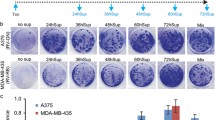Abstract
Retroviral vectors usually contain drug resistance genes, which are used to select for infected cells and to determine the viral titers. The viral titer is referred to as colony-forming units (CFUs). Color reporter genes, such as thelacZ gene and the green fluorescent protein gene(gfp), have been widely used as markers in retroviral vectors. In this report, a simple and rapid method for the determination of retroviral titers has been developed. The number of viral particles capable of forming individual green cells per unit volume is defined as marker-forming units (MFUs). The MFUs determined by usinggfp as a marker were found to be proportional to the CFUs obtained by using drug selection for five different drug resistance genes. In addition, after adjusting the time factor, the MFUs are higher than CFUs in viruses released from 30 stable helper cell lines. The lower titers determined by CFUs are likely due to the toxicity on transduced cells.
Similar content being viewed by others
References
Adam MA, Ramesh N, Miller AD, Osborne WR. Internal initiation of translation in retroviral vectors carrying picornavirus 5′ nontranslated regions. J Virol 65:4985–4990;1991.
Akroyd J, Fincham VJ, Green AR, Levantis P, Searle S, Wyke JA. Transcription of Rous sarcoma proviruses in rat cells is determined by chromosomal position effects that fluctuate and can operate over long distances. Oncogene 1:347–354;1987.
Bacchetti S, Graham FL. DNA-mediated transfer of herpes simplex virus TK gene to human TK- cells: Properties of the transformed lines. IARC Sci Publ 24:495–499;1978.
Baron M, Reynes JP, Stassi D, Tiraby G. A selectable bifunctional beta-galactosidase::phleomycin-resistance fusion protein as a potential marker for eukaryotic cells. Gene 114:239–243;1992.
Boris-Lawrie KA, Temin HM. Recent advances in retrovirus vector technology. Curr Opin Genet Dev 3:102–109;1993.
Byun J, Kim JM, Kim SH, Yim J, Robbins PD, Kim S. A simple and rapid method for the determination of recombinant retrovirus titer by G418 selection. Gene Ther 3:1018–1020;1996.
Chalfie M, Tu Y, Euskirchen G, Ward WW, Prasher DC. Green fluorescent protein as a marker for gene expression. Science 263:802–805;1994.
Cheng L, Fu J, Tsukamoto A, Hawley RG. Use of green fluorescent protein variants to monitor gene transfer and expression in mammalian cells. Nat Biotechnol 14:606–609;1996.
Coffin JM, Hughes SH, Varmus H. Retroviruses. Cold Spring Plainview, Harbor Laboratory Press, 1997.
de la Luna S, Soria I, Pulido D, Ortin J, Jimenez A. Efficient transformation of mammalian cells with constructs containing a puromycin-resistance marker. Gene. 62:121–126;1988.
Dougherty JP, Temin HM. High mutation rate of a spleen necrosis virus-based retrovirus vector. Mol Cell Biol 6:4387–4395;1986.
Levy JP, Muldoon PR, Zolotukhin S, Link CJ, Jr. Retroviral transfer and expression of a humanized, red-shifted green fluorescent protein gene into human tumor cells. Nat Biotechnol 14:610–614;1996.
Miller AD, Buttimore C. Redesign of retrovirus packaging cell lines to avoid recombination leading to helper virus production. Mol Cell Biol 6:2895–2902;1986.
Miller AD, Garcia JV, von Suhr N, Lynch CM, Wilson C, Eiden MV. Construction and properties of retrovirus packaging cells based on gibbon ape leukemia virus. J Virol. 65:2220–2224;1991.
Miller AD, Rosman GJ. Improved retroviral vectors for gene transfer and expression. Biotechniques 7:980–982, 984–986, 989–990; 1989.
Miyao Y, Shimizu K, Tamura M, Yamada M, Tamura K, Nakahira K, Kuriyama S, Hayakawa T, Ikenaka K. A simplified general method for determination of recombinant retrovirus titers. Cell Struct Funct 20:177–183;1995.
Onodera M, Yachie A, Nelson DM, Welchlin H, Morgan RA, Blaese RM. A simple and reliable method for screening retroviral producer clones without selectable markers. Hum Gene Ther 8:1189–1194;1997.
Sambrook J, Fritsch EF, Maniatis T. Molecular Cloning: A Laboratory Manual, ed 2. Cold Spring Harbor, Cold Spring Harbor Laboratory, 1989.
Sladek TL, Jacobberger JW. Rapid titration of retroviral vectors encoding intracellular antigens by flow cytometry. J Virol 64:3135–3138;1990.
Zhang J, Sapp CM. Recombination between two identical sequences within the same retroviral RNA molecule. J Virol 73:5912–5917;1999.
Zhang J, Temin HM. Rate and mechanism of nonhomologous recombination during a single cycle of retroviral replication. Science 259:234–238;1993.
Author information
Authors and Affiliations
Rights and permissions
About this article
Cite this article
Sapp, C.M., Li, T. & Zhang, J. Systematic comparison of a color reporter gene and drug resistance genes for the determination of retroviral titers. J Biomed Sci 6, 342–348 (1999). https://doi.org/10.1007/BF02253523
Received:
Accepted:
Issue Date:
DOI: https://doi.org/10.1007/BF02253523




